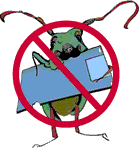The University Record, April 15, 1997
New software recommended to fight computer viruses
Editor’s Note: This article is excerpted from one by Bruce P. Burrell and Jimi Lee Haswell of the Information Technology Division in the March ITDigest. It also is available on the Web at http://www.itd.umich.edu/ITDigest/0397/feat02.html.
 U-M computer users didn’t have to worry too much about viruses until recently. The antivirus software available to them—F-PROT and Disinfectant—was widely used and offered excellent protection against computer viruses. With the release of Windows 95 and the development of Microsoft Word macro viruses, however, that situation changed. ITD conducted extensive tests of antivirus software and is now recommending a new product—Dr. Solomon’s Anti-Virus Toolkit, with versions for Macintosh, Windows and other platforms.
U-M computer users didn’t have to worry too much about viruses until recently. The antivirus software available to them—F-PROT and Disinfectant—was widely used and offered excellent protection against computer viruses. With the release of Windows 95 and the development of Microsoft Word macro viruses, however, that situation changed. ITD conducted extensive tests of antivirus software and is now recommending a new product—Dr. Solomon’s Anti-Virus Toolkit, with versions for Macintosh, Windows and other platforms.
Computer viruses have been around for about 10 years, and the antivirus software in use at the University had matters well under control. However, changes in the kinds of operating systems and programs in common use and a new kind of infection— the Word macro virus, which infects Microsoft Word version 6 and greater documents on Macintosh and Windows computers—have made the U-M environment much more open to attack.
Last August, however, two significant developments occurred that altered the situation at the University and around the world: Windows 95 was released, and the first Microsoft Word macro virus, called “Concept,” appeared. These events are closely linked, because by accident “Concept” was widely distributed to hardware and software vendors on a CD-ROM associated with Windows 95 — the “Microsoft Windows 95 Software Compatibility Test.” “Concept” has since become the most common computer virus in the world—in part because that CD-ROM infected the computers of many who received it.
The release of Windows 95 also was significant from a virus perspective because antivirus products that watch for a virus to attack—and therefore give you the opportunity to prevent such attacks—would no longer work. However, antivirus softwa re that you use to scan your computer and check for viruses does function normally with Windows 95.
What, exactly, is a computer virus? It is a program that replicates. Some viruses try to do no harm; others are intentionally destructive. No matter the intent, all viruses have negative side effects—they slow down the computer, take up disk space, and take time and effort to eradicate.
Macro viruses infect Microsoft documents, rather than the programs or applications, and are much easier to create than the older viruses. Moreover, they can spread from Macintosh to PC and vice versa, and they can be transferred as e-mail attachm ents.
Work by ITD’s Virus Busters Team last fall and winter determined that the best product for U-M needs was Dr. Solomon’s Anti-Virus Toolkit.
ITD consultants are being trained on installation and use of the antivirus software and expect to be able to answer questions very soon. In the meantime, they may refer you to the Virus Busters Team or the vendor for assistance.
Tip: Even though viruses can be spread as e-mail attachments, you cannot infect your computer merely by reading e-mail text. Do, however, be careful not to configure your e-mail program to launch attachments automatically, because they might con tain malicious programs.
|
Antivirus information is available by e-mail When new versions of antivirus software become available, or when there is some important information to share about a dangerous new infection, ITD’s Virus Busters Team sends e-mail to two e-mail groups: PC AntiVirus Update (PCAVU) and Macintosh AntiVirus Update (MACAVU). Anyone with a U-M uniqname can join these e-mail groups, which are in the X.500 Online Directory. |

